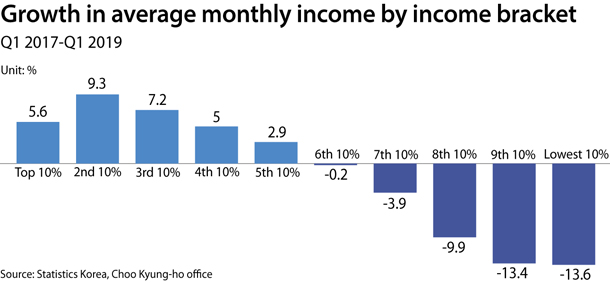Statistics suggest policy’s failure

The idea was to boost personal earnings to stimulate consumption so that Korea would shift from being export dependent to domestic led.
According to a study, it turns out that the people who were targeted are worse off, while the rich and upper middle class are better off. All that’s really been accomplished is a widening of the income gap.
The study was conducted by Liberty Korea Party lawmaker Choo Kyung-ho, who was previously a vice finance minister and also the Financial Services Commission vice chairman.
The study found that the incomes of households in the lowest 10 percent income bracket fell 13.6 percent from the first quarter of 2017, right before the Moon government came into office in May, to the first three months of this year.
For the next 10 percent income bracket, the fall was 13.4 percent.
Incomes for those in the top 10 percent category were up 5.6 percent, while incomes for those in the next highest category rose 9.3 percent.
The benefits provided by the Moon administration are seen as leading to the declines.
“It seems [the decline in income] resulted from job losses especially for people in the economically vulnerable class due to the sharp increase in the minimum wage and the unilateral implementation of the shorter workweek,” said Choo. “The income-led growth, which was to create a positive circulation in economy by raising the income of the low-income households actually resulted in a side effect where the living standard of lower income households have retreated.”
People in the middle of the pack, the middle class, did well, but not as well as the rich.
“The income-led growth, which was pushed with the goal of narrowing inequality in income, has actually worsened that gap,” said Yoo Gyeong-joon, Korea University of Technology and Education professor, who served as Statistics Korea commissioner.
The lawmaker’s study has also found that the lower-income households are becoming more dependent on government handouts.
Transfer income of those in the bottom 10 percent category in the first quarter of this year was 84.6 percent of the total income. This is a sharp rise from the 69.2 percent two years ago. The transfer income of those in the next 10 percent rose to 72.5 percent from 54.6 percent in the first quarter of 2017.
The rising dependency indicates that lower-income households are becoming more reliant on government financial support as their incomes have been shrinking.
“The current situation where transfer income continues to expand while labor income is shrinking will not be helpful in building the economic self-reliance of lower income households,” said Prof. Yoo.
When announcing household income, Statistics Korea does not include those living alone. Some argue that the report now needs to include single households to properly assess and evaluate household income.
BY SOHN HAE-YOUNG [lee.hojeong@joongang.co.kr]










with the Korea JoongAng Daily
To write comments, please log in to one of the accounts.
Standards Board Policy (0/250자)